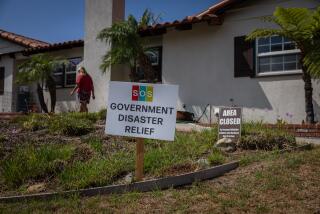Locoweed Host Thinned by Development : Palos Verdes Blue Butterfly Disappears
Kneeling beside a small plant on a Rancho Palos Verdes hillside, lepidopterist Jess Morton examines a cluster of pods that adorn it like gaudy bangles, looking for any vestige of the caterpillar. But the pods of this native locoweed are intact, leading Morton to conclude that it is not serving as a nursery for the Palos Verdes blue butterfly.
And chances are remote that this strain of locoweed--which is disappearing rapidly because of development and land clearance for fire protection--will ever again serve as an incubator and food plant for the elusive butterfly that is native only to the Palos Verdes Peninsula.
âI think itâs quite likely they are gone,â said Morton, an accountant by profession and a former president of the Palos Verdes Audubon Society. âLast year I thought the prediction (that the butterflies were extinct) was premature. Iâm not so sure now.â
Entirely dependent on the locoweed for its survival, the butterfly--which looks like a small petal of silvery blue tossed in the breeze--has become a victim of habitat destruction.
Not Yet Official
Although the endangered species office of the U.S. Fish and Wildlife Service has yet to officially declare the butterfly extinct, hunts this year--and last year--by amateur and professional biologists failed to turn up any trace of the blue.
âIf there had been anything, we would have found it,â said biologist Rudi Mattoni, a private entomologist. âItâs over.â
Despite these gloomy assessments, there will be searches for the blue again next year, according to Sam Jojola, special agent with the Fish and Wildlife Service. But he agreed that the butterfly probably is gone forever.
If the Palos Verdes blue is officially declared extinct, it will be the first organism to disappear that was known to exist when it was listed as an endangered species, according to the Fish and Wildlife service. It was put on the list in 1980.
No more than half a dozen of the butterflies were counted in 1983. When none were found in 1984, it was hoped that the dry weather conditions that year had caused an extended hibernation--or chrysalis--stage and that what didnât appear in 1984 would flutter forth in abundant blue beauty this year.
Short Flying Period
The blue traditionally flies during February and March, and this schedule, early by butterfly standards, kept it isolated from scientists until 1977, when it began to be studied. But by then, housing developments and land clearances by the county had wiped out significant groups of blues and had isolated others.
Mattoni said the butterflies could not move, perhaps because of distances between one patch of plants and another.
Richard Arnold, a University of California, Berkeley, entomologist who specializes in the Palos Verdes blue, said the habitat areas left are small and have few plants. âThe likelihood of any of the butterflies surviving in those areas from one year to the next is fairly minimal,â he said.
Numerous trips to the Peninsula have convinced him that the blue no longer lives: âIn addition to looking for the adults, I sampled the seed pods of the plants that the butterfly larvae feed on in the caterpillar stage. I looked at a very high percentage of the seed pods that were produced this year and found no signs of the larvae.â
Arnold said that when he has located new areas of habitation, he invariably has found them damaged by fire control methods or, on return trips, destroyed by development.
Little Action
While Arnold said he was prompt in regularly apprising Fish and Wildlife of his research, he did not relay the information to the City of Rancho Palos Verdes because he assumed that the fish and wildlife agency would do so. But, he said, the agency âcertainly did not do everything it was supposed to doâ and the city âcould have done a little more about getting better information or having more qualified people do more survey work in the area.â
One communications failure cited by Arnold and others involved the development of Fred Hesse Community Park, a splash of green atop the Peninsula overlooking the Pacific Ocean. In 1983, the city determined that use of a specific area for a baseball diamond would not threaten the butterflies, when in reality that region contained the greatest density of the remaining Palos Verdes blues.
Alice Angus, associate planner in Rancho Palos Verdes environmental services office, said the cityâs environmental work was reviewed by the California Governorâs Office of Planning and Research, and there were no objections. She said the city learned later that a supposed habitat had been destroyed.
Mayor John McTaggart, who was a planning commissioner when the park was developed, said the city âalways tried to work with the agencies that approached us about the butterfly.â He said no one complained about butterfly destruction until grading had been completed.
Not Much Support
âInsects in general have not gotten very good treatment,â Arnold lamented. âEven though (endangered insects) have all the rights of protection of the California condor, they just donât seem to get the support.â
Said Mattoni, âWeâre really irrevocably screwing up the world ecosystem. Every time you pop a species, itâs just one more index of the destruction thatâs being wrought.â






